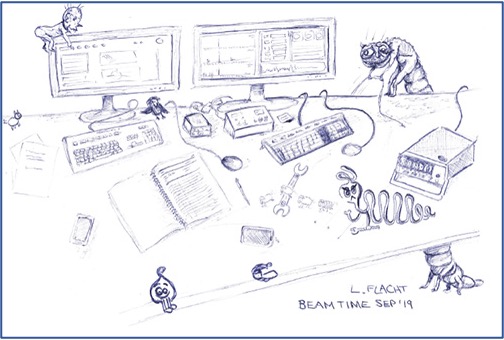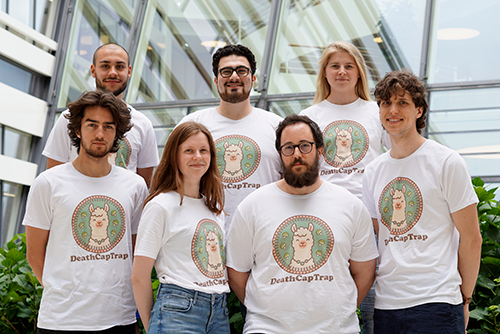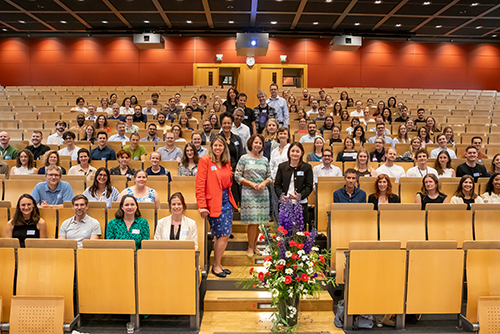Antibiotics - Blunt Weapons?
Whether in a strawberry flavoured, liquid form as a child or in tablet form as an adult, most individuals have taken antibiotics. Once our pain is gone, we move on with our daily lives giving little thought to the medication that has enabled us to do so. The availability and effectiveness of antibiotics is often taken for granted. As an increasing number of bacteria develop resistance to certain antibiotics, we must begin to consider the implications of antibiotic resistance on our society and the ways in which science and industry can work together to prevent a post antibiotic era.
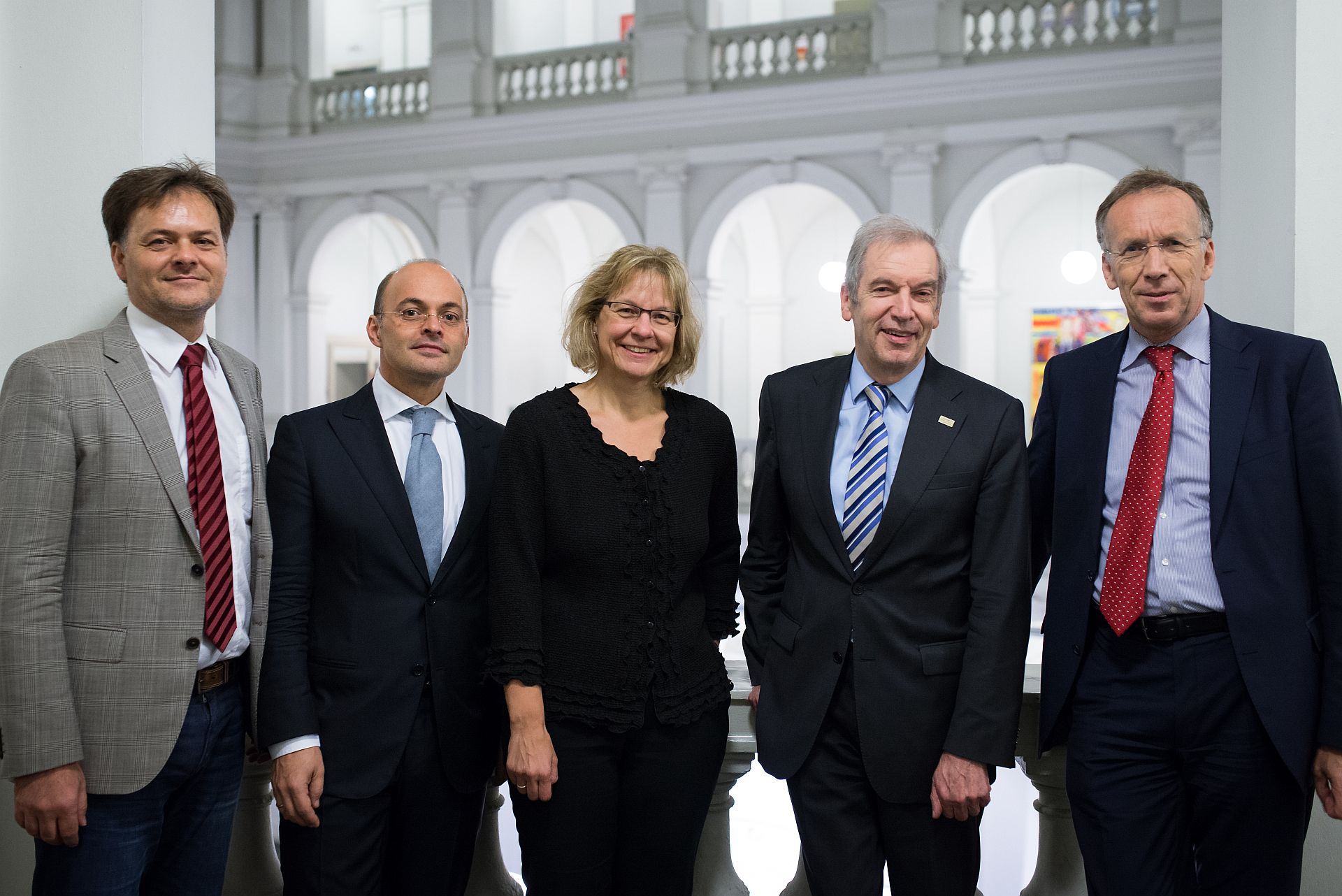
To help bring this issue into the spotlight, the Centre for Structural Systems Biology (CSSB) and the Academy of Sciences and Humanities in Hamburg hosted a panel discussion on 8 November 2016 entitled “Antibiotics – Blunt Weapons?” The panel was comprised of Prof. Petra Dersch, Head of the Department Molecular Infection Biology, at Helmholtz Centre for Infection Research; Dr Werner Lanthaler, CEO of Evotec; Prof. Ansgar Lohse, Director of the Centre for Internal Medicine at University Medical Centre Hamburg-Eppendorf (UKE) and Prof. Thomas Marlovits, Deputy Scientific Director of the Centre for Structural Systems Biology. This panel of four experts from medicine, science and industry discussed the challenges in combating antibiotic resistance as well as the opportunities that exist for collaboration.
Antibiotic Resistance
Bacteria have inhabited the earth for over two millions years. Their ability to share genetic elements with other bacteria enables them to quickly adapt to new threats and develop resistance against “attackers” such as antibiotics. “The existence of antibiotics is a natural phenomenon, that antibiotic resistance exists is also a natural phenomenon. There will always be new antibiotics and new resistances,” explained Prof. Lohse. Resistance is a fundamental principle of evolution, our efforts can slow down the process of antibiotic resistance but it is ultimately one that we cannot stop. To ensure its own survival, bacteria must develop resistance to antibiotics.

As bacteria are continually building up their arsenal of resistance, one would assume that humans continue to create stronger antibiotics. This is however not the case - the last class of new antibiotics was developed in the 1980’s. Dr Werner Lanthaler, CEO of Evotec, a Hamburg based drug discovery and development company, provided insight into why there are currently no new antibiotics on the market. “The belief in the 70’s, 80’s and 90’s was that antibiotics are not a profitable business. In comparison to some medications which are taken on a daily basis, antibiotics are typically prescribed for a single, short period of time and thus provide a much lower return on investment,” explained Lanthaler “This short-sightedness was a mistake and today we are all paying the price.”
As a result of this mistake, scientific breakthroughs have not been translated into marketable products and this has led to a gap in the drug pipeline. “Evotec is currently working with closely with scientists to help create a bridge between academic research and industry,” explained Lanthaler “but at the moment we have almost nothing in phase 2 or 3 of drug development. In fact, we have very few projects in phase 1.” The gap in the drug pipeline is unfortunately not something that simply be filled over night; the development of new antibiotics requires both time and money. The creation of a new antibiotic takes approximately ten to fifteen years and costs over one billion euros.
Understanding Bacteria
Scientists like Prof. Petra Dersch, Head of the Department Molecular Infection Biology, at Helmholtz Centre for Infection Research, investigate antibiotic resistant bacteria as well as other pathogens which cause infectious diseases. “Our goal,” explained Dersch “is to understand the principles of how pathogens trigger disease and at the same time to understand how our immune system fights disease.” Dersch’s research focuses on gastrointestinal infections caused by bacteria such as Shiga toxin-producing E. coli (STEC) which can lead to the life-threatening complications such as haemolytic uraemic syndrome (HUS). The city of Hamburg is familiar with STEC as in 2011 over 3,000 individuals in northern Germany were infected with a strain of the bacteria that resulted in 53 fatalities.
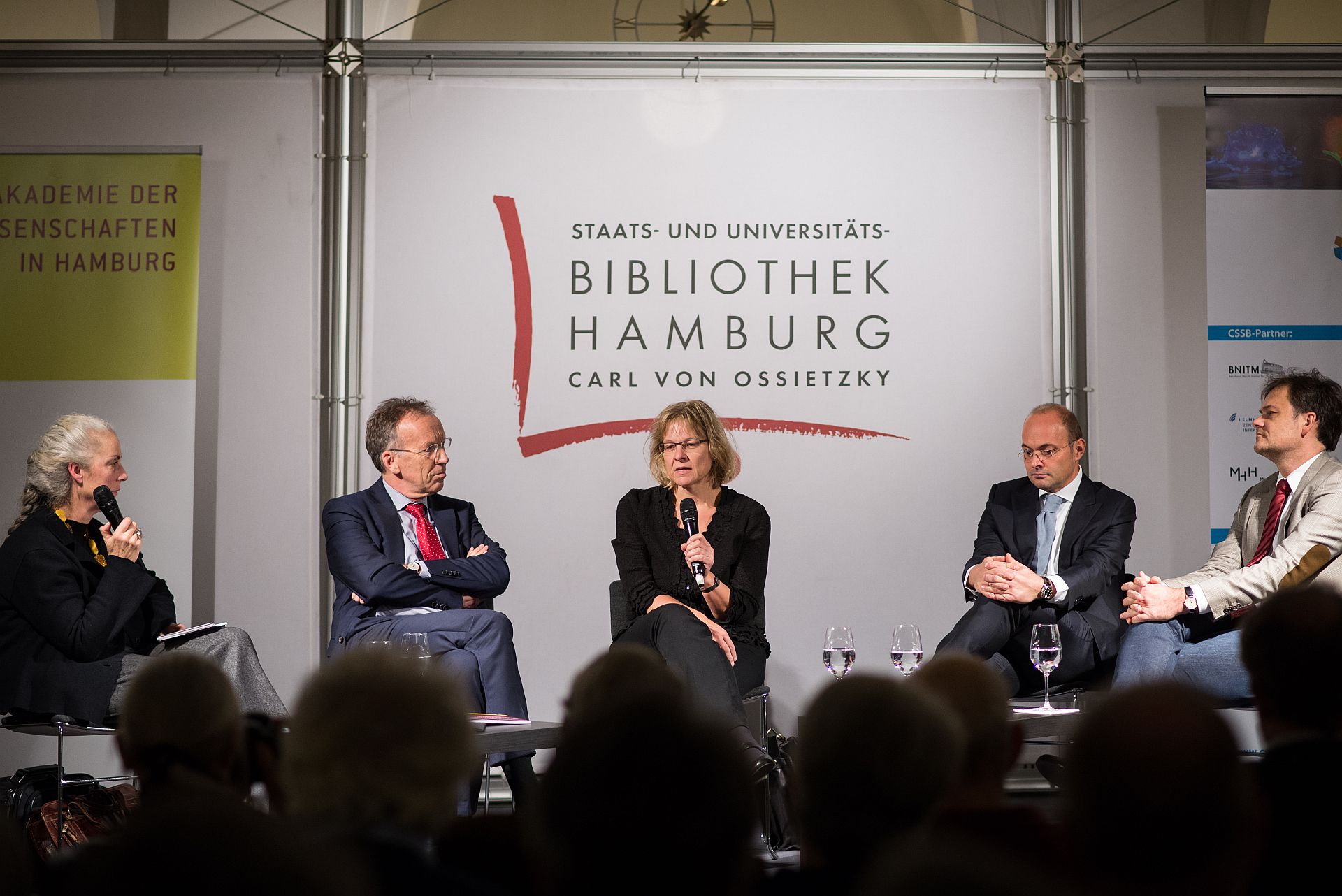
There is currently no evidence that antibiotics help in the treatment of individuals suffering from an infection caused by STEC. Prof. Dersch explained that the membrane surface of the bacteria is lined with miniscule injection needles that are responsible for transferring proteins responsible for transmitting the infection to host cells. Her research group at HZI is looking into how this needle can be stopped “An idea that we have and are trying to implement is whether a small molecule could bind to the bacteria’s surface and prevent the needle complex from injecting its protein into the hosts’ blood cell,” explained Dersch.
The research of Prof. Thomas Marlovits also seeks to understand the underlying mechanisms of this bacterial needle complex as well as other molecular machines. To view these mechanisms in their native state Prof. Marlovits uses electron cryo microscopy which is one of the key technologies that will be implemented in the new CSSB building. “These microscopes allow us to observe the interactions between bacteria and their hosts at the molecular level and will hopefully lead to the discovery of new target molecules,” explained Marlovits.
Fostering collaboration
All panel members expressed the importance of ensuring that the breakthroughs of fundamental research do not remain in the realm of academia. “It is important to build a bridge between academia and industry, once we have results we must sit down with companies” stated Prof. Marlovits. “From the side of industry, we cannot start this process early enough,” explained Dr Lanthaler “Of the 200 translation projects for infectious disease taking place right now only 1% will succeed. To find this 1% we must have as many start-up projects as possible.”
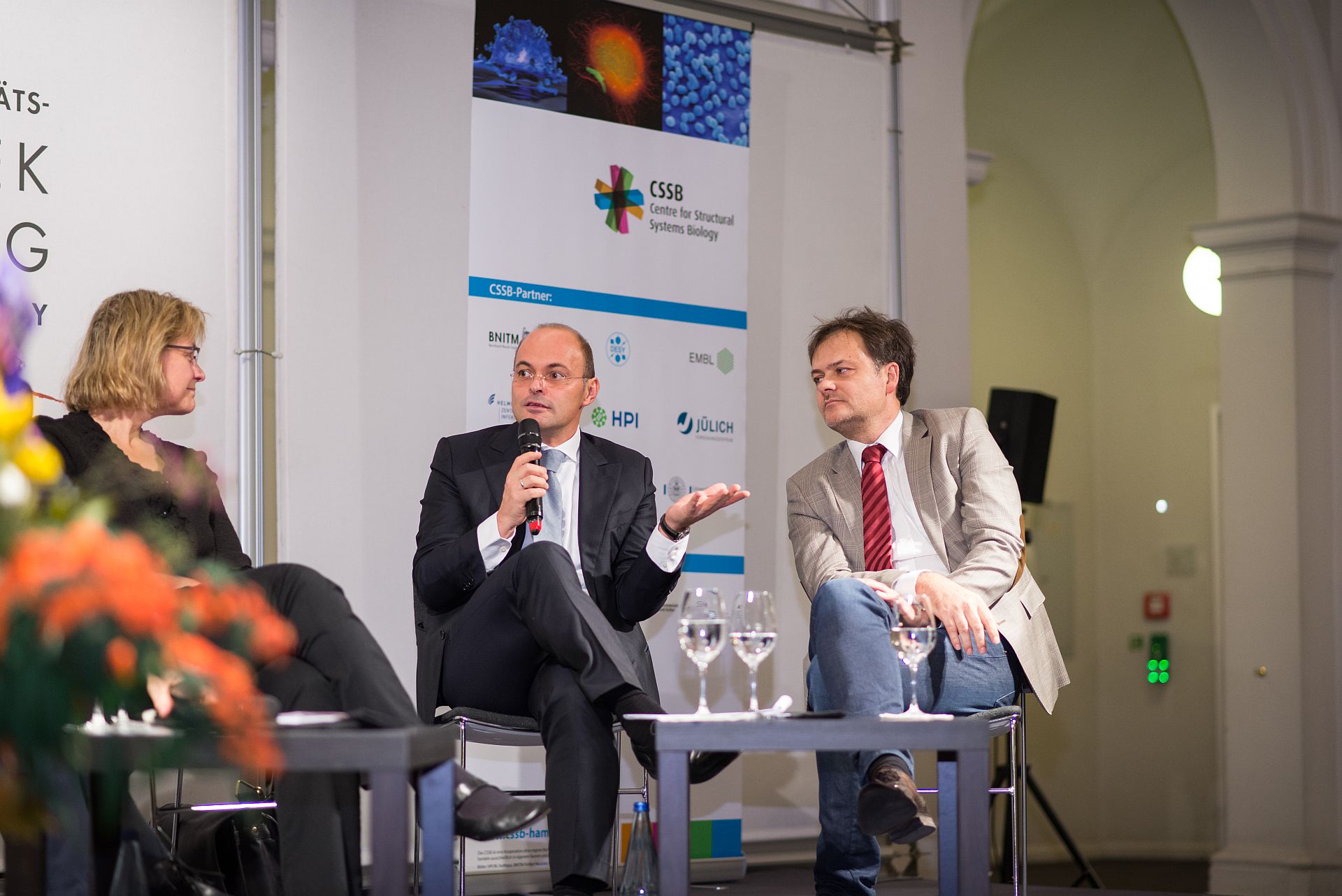
To build bridges that facilitate collaboration incentives must be offered to both parties. Dr Lanthaler described an Evotec project being conducted in collaboration with scientist from Harvard University. The project is unique in that it will provide the university with a percentage of the resulting medications profit. Prof. Lohse mentioned the development of an Ebola vaccine as another example of a successful collaboration. The fundamental research for the vaccine was funded by the German ministry of health and the Wellcome Trust and the clinical testing was immediately taken over by pharmaceutical company, Merck. Given the extremely high cost of developing antibiotics, more investments must be made by both governments and private foundations to incentivize collaboration. “Current investment sums are a drop of water on a hot stone – we need more,” explained Prof. Lohse.
Filling the gap
New antibiotics should be developed and ready for use in 2030. How do we fill this gap? Dr Lanthaler suggested focusing on preventative measures such as improving hospital hygiene to reduce infection rates and thus decrease the need for antibiotic use. “Hospitals also need to cooperate with one another and share their experiences,” he explained “for example hospitals with a high quota of MSRA could learn from those with a much lower quota.” According to Prof. Lohse, changing how antibiotics are prescribed could also reduce overall consumption and help slow the pace of resistance. “We need to give more targeted antibiotics and overall fewer antibiotics,” he explained “but this is not always easy. When we are ill, we expect to receive the best possible treatment and this includes the best antibiotics.”
Informing the general public regarding sustainable antibiotic use as well as raising awareness about antibiotic resistance is therefore crucial. To inform individuals about antibiotic resistance, the European Centre for Disease Prevention and Control sponsors the European Antibiotic Awareness Day on November 18 each year. Such initiatives provide essential information however; changing mind-sets is often easier than inspiring action. “We are all aware of climate change but many in this audience still drove a car to attend this event and the room is well heated – we could have taken public transport or keep our jackets on,” noted Prof Lanthaler.
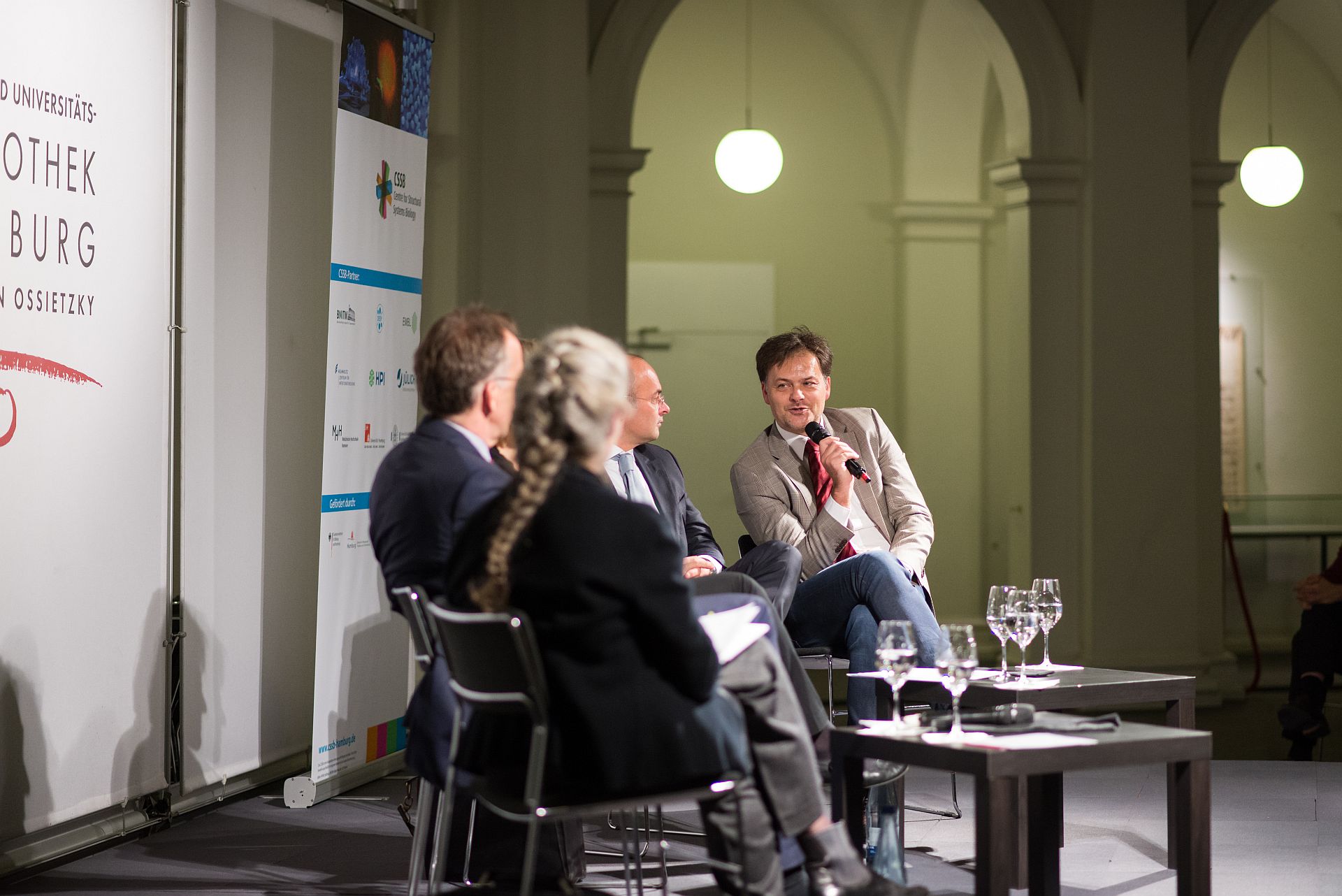
Gaining Momentum
“Are antibiotics blunt weapons?” inquired an audience member at towards the end of the discussion. “No, they remain sharp” replied Prof. Marlovits “but the way we are using them is reducing the pool.” His reply was one of hope and with a hint of a warning. While there are many challenges to overcome in combatting antibiotic resistance, more awareness is being increasingly generated about the issue. The issue was thrown into the international spotlight in September of this year when the United Nations held a High-level Meeting on Antimicrobial Resistance during which member states signed a declaration agreeing to combat antimicrobial resistance. One can only hope that this increase in awareness will result in a more sustainable use of antibiotics by individuals, a larger investment in innovative projects by both government and other funding bodies and closer and more fruitful collaborations between research organizations and industry. As Charles Darwin, the father of evolutionary biology, once noted “In the long history of humankind (and animal kind, too) those who learned to collaborate and improvise most effectively have prevailed.”
